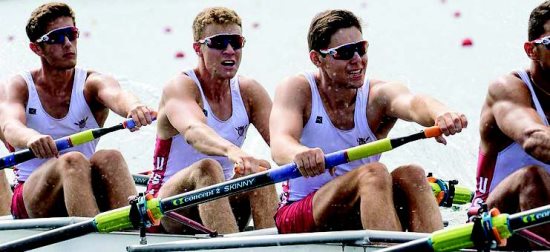What is that makes a top rower? To simplify, it’s strength, endurance and technique. Needless to say, there is a lot of discomfort as you push yourself to your perceived limits. According to Hooper: “Handling the discomfort is the hardest trick. You don’t talk about the pain. The most successful rowers learn how to manage it.”
The most crucial machine in training is the ergometer. referred to by the rowers as the “erg.” It is the one objective measurement for rowers. Ergometer tests are used by rowing coaches to evaluate rowers and is part of athlete selection for many senior and junior national rowing teams. During a test, rowers will row a set distance and try to clock the fastest time possible, or a set time and try to row the longest distance possible. The most common distances for erg tests are 2000, 5000, 6000 or 10,000 meters.
Both Kate and Nikita use the erg to judge how well they have improved. Though Nikita values those numbers as a tool, he also understands that “Ergs don’t float. Technique is a huge aspect and difference between good and bad rowers.”
According to Hooper: “I could have a week long conversation about technique. It is crucial to do it right. When it is done perfectly, it looks like you’re not working that hard. It takes a lot of time and patience to learn it correctly.”
Kate participated in a lot of sports prior to rowing and “I was in good shape to begin with but it took a while to develop the correct technique and I still have a long way to go.”
According to Nikita: “What really helped me develop was the team aspect – being with the team all the time you push them and they push you. You remember how the next stroke you are going to take will impact the race. You think about each stroke as you make it.
The key to De Regt is to get “an understanding of how to work with the water. It’s not complicated. You can learn 90 percent of the proper technique in the first week but it may take 10 years to learn the finest points.”
Nikita attributes his improvement in technique to De Regt and to Jesse Foglia, an assistant coach at Harvard who was his coach with the national team.
Being invited to tryout for the Junior National Team was just the first step. Making the team was even more difficult. Kate saw it as a real challenge: “It was very competitive because everyone there was very talented and athletic.” Once again, the rowers were tested on the erg machine on land and in speed racing tests where the rowers competed with various partners in different boats to select the top rowers.
Kate was chosen to row in the quadruple sculls, a four-person boat with each of the rowers handling two oars, ultimately finishing in fifth place.
It was a truly memorable experience for Kate: “There were over 50 countries represented there. It was an opportunity to see lots of different techniques and see how some worked better than others. Though there was little interaction with the other teams during the competition, at the end we traded our team gear with the rowers from the other countries. I took great pride in representing the United States. I have also maintained relationship with many of my teammates who came from all over the country”
Last year was Nikita’s second year on the national team. Each year he was on the team, he rowed on the eight man crew, finishing second twice in the international competiton, losing out to Germany by one second in this years finals. The most difficult part of working with the national team was the fact that his teammates came from all over the country. According to Nikita: “Since there were a number of techniques used by the rowers, the first thing the coaches had to do was to get everyone to row with the same technique.”
Just getting to Lithuiana was very difficult as the team had to take three 3 connecting flights to get there.
Regardless, it was worth it to Nikita: “Once there, it was a great experience. We were one of the first teams there, arriving about a week before the competition. It was great to see the various teams – the languages and the colors. It was an honor to represent the United States amidst the various countries. That was the highlight of the experience.”
Nikita will be starting his freshman year of college and will be rowing for Stanford as well. As hard as he has worked in high school and for the national team, he sees rowing in college as a real demand for him to organize his time: “I am going to have to be more efficient with my time than in high school. Three days a week, we will be practicing at 5:45 a.m. Their boathouse is 20 minutes away from campus and we will be practicing for 2 ½ hours and then it’s back to campus and classes.”
Kate, who will be a senior this year at Campolindo is being recruited by a number of colleges and anticipates competing in college as well.
Nikita would like to see the sport continue to grow in the Lamorinda area: “I would really encourage people to try rowing. It’s a sport that is not that well known. Yet with all the other sports available, a lot of people are discovering this to be a sport where they fit in. A lot of people go into rowing as true beginners but after just a couple of years, they can improve rapidly if the commitment is there. Oakland Strokes is a great organization that tries to reach out to a wide range of people.”


















